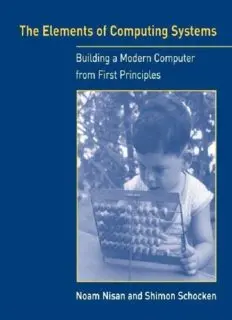Table Of ContentTable of Contents
Title Page
Copyright Page
Dedication
Preface
Introduction
Chapter 1 - Boolean Logic
1.1 Background
1.2 Specification
1.3 Implementation
1.4 Perspective
1.5 Project
Chapter 2 - Boolean Arithmetic
2.1 Background
2.2 Specification
2.3 Implementation
2.4 Perspective
2.5 Project
Chapter 3 - Sequential Logic
3.1 Background
3.2 Specification
3.3 Implementation
3.4 Perspective
3.5 Project
Chapter 4 - Machine Language
4.1 Background
4.2 Hack Machine Language Specification
4.3 Perspective
4.4 Project
Chapter 5 - Computer Architecture
5.1 Background
5.2 The Hack Hardware Platform Specification
5.3 Implementation
5.4 Perspective
5.5 Project
Chapter 6 - Assembler
6.1 Background
6.2 Hack Assembly-to-Binary Translation Specification
6.3 Implementation
6.4 Perspective
6.5 Project
Chapter 7 - Virtual Machine I: Stack Arithmetic
7.1 Background
7.2 VM Specification, Part I
7.3 Implementation
7.4 Perspective
7.5 Project
Chapter 8 - Virtual Machine II: Program Control
8.1 Background
8.2 VM Specification, Part II
8.3 Implementation
8.4 Perspective
8.5 Project
Chapter 9 - High-Level Language
9.1 Background
9.2 The Jack Language Specification
9.3 Writing Jack Applications
9.4 Perspective
9.5 Project
Chapter 10 - Compiler I: Syntax Analysis
10.1 Background
10.2 Specification
10.3 Implementation
10.4 Perspective
10.5 Project
Chapter 11 - Compiler II: Code Generation
11.1 Background
11.2 Specification
11.3 Implementation
11.4 Perspective
11.5 Project
Chapter 12 - Operating System
12.1 Background
12.2 The Jack OS Specification
12.3 Implementation
12.4 Perspective
12.5 Project
Chapter 13 - Postscript: More Fun to Go
13.1 Hardware Realizations
13.2 Hardware Improvements
13.3 High-Level Languages
13.4 Optimizations
13.5 Communications
Appendix A: - Hardware Description Language (HDL)
Appendix B: - Test Scripting Language
Index
© 2005 Massachusetts Institute of Technology
All rights reserved. No part of this book may be reproduced in any form by any electronic or mechanical
means (including photocopying, recording, or information storage and retrieval) without permission in
writing from the publisher.
This book was set in Times New Roman on 3B2 by Asco Typesetters, Hong Kong.
Printed and bound in the United States of America.
Library of Congress Cataloging-in-Publication Data
Nisan, Noam.
The elements of computing systems: building a modern computer from first principles / Noam Nisan and
Shimon Schocken.
p. cm.
Includes bibliographical references and index.
ISBN 0-262-14087-X (alk. paper) 1. Electronic digital computers. I. Schocken, Shimon. II. Title.
TK7888.3.N57 2005
004.16—dc22
2005042807
10 9 8 7 6 5 4 3 2 1
Note on Software
The book’s Web site (http://www.idc.ac.il/tecs) provides the tools and materials necessary to build all the
hardware and software systems described in the book. These include a hardware simulator, a CPU emulator,
a VM emulator, and executable versions of the assembler, virtual machine, compiler, and operating system
described in the book. The Web site also includes all the project materials—about 200 test programs and
test scripts, allowing incremental development and unit-testing of each one of the 12 projects. All the
supplied software tools and project materials can be used as is on any computer equipped with either
Windows or Linux.
To our parents,
For teaching us that less is more.
Preface
What I hear, I forget; What I see, I remember; What I do, I understand.
—Confucius, 551-479 BC
Once upon a time, every computer specialist had a gestalt understanding of how
computers worked. The overall interactions among hardware, software,
compilers, and the operating system were simple and transparent enough to
produce a coherent picture of the computer’s operations. As modern computer
technologies have become increasingly more complex, this clarity is all but lost:
the most fundamental ideas and techniques in computer science—the very
essence of the field—are now hidden under many layers of obscure interfaces
and proprietary implementations. An inevitable consequence of this complexity
has been specialization, leading to computer science curricula of many courses,
each covering a single aspect of the field.
We wrote this book because we felt that many computer science students are
missing the forest for the trees. The typical student is marshaled through a series
of courses in programming, theory, and engineering, without pausing to
appreciate the beauty of the picture at large. And the picture at large is such that
hardware and software systems are tightly interrelated through a hidden web of
abstractions, interfaces, and contract-based implementations. Failure to see this
intricate enterprise in the flesh leaves many students and professionals with an
uneasy feeling that, well, they don’t fully understand what’s going on inside
computers.
We believe that the best way to understand how computers work is to build
one from scratch. With that in mind, we came up with the following concept.
Let’s specify a simple but sufficiently powerful computer system, and have the
students build its hardware platform and software hierarchy from the ground up,
starting with nothing more than elementary logic gates. And while we are at it,
let’s do it right. We say this because building a general-purpose computer from
first principles is a huge undertaking. Therefore, we identified a unique
educational opportunity not only to build the thing, but also to illustrate, in a
hands-on fashion, how to effectively plan and manage large-scale hardware and
software development projects. In addition, we sought to demonstrate the ability
to construct, through recursive ascent and human reasoning, fantastically
complex and useful systems from nothing more than a few primitive building
blocks.

